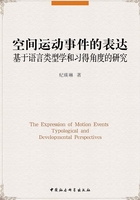
1.4 SYNOPSIS
As previously noted, the study of spatial language, particularly motion expressions in Chinese versus English, is very important because it contributes to the issue of spatial typology, to the knowledge of language acquisition of Chinese and to the relation between language and thought in general.The present study has the following characteristics.First, it focuses on two languages that exhibit both similarities and differences regarding motion expressions.It examines the packaging of all semantic components for motion (i.e.Figure, Ground, Motion, Path, Manner, Cause) through all possible grammatical means (e.g.verbs, prepositions, nouns, subordinated clauses) across the utterance.Second, it focuses on motion events involving changes of location.These particular motion events are known as ‘translocational’ events and the defining property of them is that an object's basic location shifts from one point to another in space.Note that these translocational motion events stand in stark contrast not only to situations of static location but also to ‘self-contained’ motion events which only involve a general location (rather than changes of location) associated with dynamic events.The difference among these events and situations are exemplified below, with the structure illustrated in (4c) representing the focus of this book.
(4)a.The boy is in the woods.[situation of static location]
b.The boy is walking in the woods.[self-contained motion event involving a general location only]
c.The boy is walking into the woods. [translocational motion event involving changes of location]
Third, the present study examines the debate concerning universal versus language-specific determinants in language acquisition.As earlier detailed, there exist different views regarding the scope of language-specific influence.Some hold that language-specific factors mainly affect our linguistic behavior and have no significant impact on the mental representation of space at a deeper level, whereas others believe in a strong version of the Whorfian hypothesis and argue that language-specific influences go beyond the level of linguistic behavior and at least partially determine a speaker's non-linguistic representation of space at the cognitive level throughout development (Hickmann and Hendriks 2006: 105).This book limits its scope to the online verbal behavior of speakers and does not delve into language-specific influences on the cognitive construction of space, although it may provide some interesting insight into the issue.Finally, the developmental study in the book involves children from as many as seven age groups, as will be explained in Chapter 4.It is believed that the density of age groups will help us determine more accurately when a significant developmental progression occurs (if at all) during children's language development.
This book consists of seven chapters.The first three chapters are devoted to the theoretical background of the current study.Specifically, in this chapter (Chapter 1) the major aims and the rationale of the research are introduced.In Chapter 2, relevant literature on motion event typology is first reviewed and different lexicalization patterns of motion events across languages are illustrated and compared.Particular attention is directed to Talmy's classification of satellite-framed versus verb-framed languages and Slobin's relatively recent proposal of an additional type of “equipollently-framed” language.Secondly, literature describing the influence of cognitive primitives versus language specificity in the course of language development is explored in detail.Chapter 3 provides a systematic description of grammatical devices for expressing motion events in English and Chinese in order to provide a linguistic background for the later review of empirical findings regarding the use of these devices.With regard to English, Path satellites, Manner verbs and the expression of caused motion events are discussed.With regard to Chinese, the use of the resultative verb compound (RVC) in the expression of both voluntary and caused motion events is investigated in detail, and other grammatical constructions that can be used for the expression of caused motion are also reviewed.
Chapter 4 introduces the general research questions and hypotheses of the present study, as well as the research methodology, including experimental design, procedures for data collection and details on data coding.The results of the experiments conducted-namely, the voluntary motion task and the caused motion task-are reported in Chapters 5, 6 and 7.Specifically, Chapter 5 reports findings of our typological comparison between Chinese and English with respect to the following aspects of the expression of motion: (1) the selection of semantic information to be expressed and the frequency of expression of such information; (2) the locus of a given information component in an utterance; (3) the overall semantic density of an utterance; (4) the local information density both within the verb and outside; and (5) the organization of selected semantic components on the discourse level.Based on the findings reported, the typological properties of Chinese are re-examined by comparing it with a clearly satellite-framed language, English, and a clearly verb-framed language, French.A proper typological place for Chinese along a satellite-framed / verb-framed continuum is then proposed.
Chapters 6 and 7 report findings of Chinese and English children's acquisition of expressing voluntary and caused motion events respectively.In each chapter, the developmental progression within the relevant language is first discussed and then cross-linguistic variations are explored by age group.The impact of both factors, language and age, is considered and the role of each factor in children's language development is thereby determined.Other possible factors which may affect the expression of motion events-mainly event type (i.e.UP, DOWN, ACROSS, INTO)- are also discussed in Chapter 7.
Finally, in the concluding chapter (Chapter 8), the main findings of the present study are summarized from typological and developmental perspectives and the relationship between language and thought is briefly discussed beyond the level of linguistic expression into the depth of mental conceptualization of motion events.
[1] Slobin in several studies uses Mayer's (1969) wordless picture book ‘Frog,where are you?’ to elicit oral narratives from speakers of different languages and across ages.The original picture book illustrates how a boy and his dog search for a lost pet frog in various places.The oral narratives elicited are known as Frog stories (Berman and Slobin 1994), which now form a database involving 10 languages.